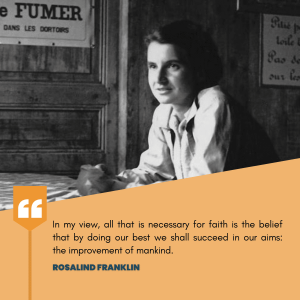As a child, your mind is initially a blank slate.
But as you mature, you gain insight into how certain men and women fit into different compartments of society, which is partially based on the combination of stereotypes which the media ingrains in us, and a juxtaposition of historical and cultural forces.
One of the things that we learn early on is that some careers are meant for men, while others are more suited for women. Specifically, though: that women are better fit for caretaker- and nurturer-based roles, such as teachers, nurses, and parents.
Meanwhile, we learn that men are more fit to succeed in STEM careers.
In fact, studies demonstrate that STEM-related gender stereotypes emerge in early childhood, impacting youths’ views on their abilities.
However! We live in the 21st century—and have clearly broken this notion. Nice work, gals.
Now let’s look at some of the magnificent ways in which women have, indeed, broken this gender stereotype, and specifically, how they’ve made their mark in STEM.
The Matilda Effect: affecting invisible women since…forever
Diving into most history books, you learn that STEM is a space for men, and also, that men are responsible for the majority of groundbreaking accomplishments in this field.
Usually, though, there’s an invisible woman (or several) pulling strings behind the scene—and this woman may contribute greatly to STEM, but unfortunately, may not be visible to many of us.
In 1993, Cornell University historian of science Margaret Rossiter coined the term “the Matilda effect” to describe the failure to recognize female scientists and their achievements.
Rossiter devised the concept for suffragist and abolitionist Matilda Josalyn Gage, who wrote the essay “Woman as an Inventor” (1893), which objected to the common notion that women shouldn’t be in science. Gage demonstrated that, not only is this ignorant, but that some of the most influential inventions in STEM are due to women.
And a casual 100+ years later, the History of Science Society named a prize after Rossiter, and created a series on some of the Matilda effect victims.
These pioneering women rarely receive the recognition they deserve. During this year’s Women’s History Month, let’s recognize some of the hidden women in STEM.
Nettie Stevens (1861–1912)
In 1906, American geneticist Nettie Stevens discovered two things:
- Male beetles produce sperm with a large chromosome, and with a small chromosome.
- When the sperm with the large chromosome fertilizes eggs, it produces female offspring, and when the sperm with the small chromosome fertilizes eggs, it produces male offspring.
Using these observations, Stevens became one of the first to establish that a particular arrangement of chromosomes determines sex. Scientists saw this pattern in other animals (including humans), which became known as the XY sex-determination system (think: punnett squares).
At the time, the common belief was that the mother and/or environmental factors determined sex—consequently, many scientists didn’t welcome Stevens’ theory.
While pursuing her Ph.D. at Bryn Mawr College, Stevens met professors Thomas Hunt Morgan and Edmund Beecher Wilson. Hunt and Wilson sent letters of recommendation to the Carnegie Institution of Washington on behalf of Stevens, who was seeking funding for research.
After receiving a grant, Stevens used insect germ cells to examine sex variations in chromosomal structure.
Although Stevens and Wilson worked together on chromosomal sex determination, many textbooks give Wilson sole credit, because he was a more accomplished researcher. Morgan has also received credit, particularly after receiving a Nobel Prize.
However, according to The Embryo Project Encyclopedia, the papers published after 1905 demonstrate that both Wilson and Morgan were apprehensive about adopting a fully chromosomal theory for several years.
Lise Meitner (1887–1968)
Lise Meitner, an Austrian physicist, was the first to establish nuclear fission, the process in which an atom’s nucleus splits into two “daughter” nuclei.
After obtaining her doctorate degree in 1906, Meitner traveled to Berlin to study with chemist Otto Hahn. They worked together for 30 years, studying radioactivity and ultimately discovering the element protactinium.
In 1923, Meitner discovered radiationless transition, the event in which electrons can go from one state to the other (from a low to high vibrational state) without releasing a photon (a tiny mass of electromagnetic radiation).
Today, this is known as the Auger effect, named after Pierre Victor Auger, the scientist who discovered the event two years later.
In 1938, after Hitler rose to power, Meitner had to leave Germany because of her Jewish roots. She fled to Sweden to continue her work.
Hahn and Meitner’s experiments were published in 1939 in Berlin; during the same year, Meitner published the physical explanation for the observations, and named the process ‘nuclear fission’.
In 1944, Hahn received the Nobel Prize in chemistry for his research in fission, and Meitner was ignored.
Alice Augusta Ball (1892–1916)
Known for developing the ‘Ball Method,’ Alice Augusta Ball was the chemist who developed the only working treatment for leprosy until antibiotics.
After becoming the first woman to graduate with a M.S. degree in chemistry from the University of Hawaii, 23-year old Ball devised a technique for treating leprosy that involved injecting the body with chaulmoogra tree seed oil.
Ball successfully discovered how to extract the oil from the chaulmoogra tree seeds and transform it into an injectable form (the ‘Ball Method’).
Unfortunately, due to complications in the lab, Ball passed away at 24, and couldn’t continue her work.
Fortunately (or, unfortunately), someone else was ready.
Arthur L. Dean, president of the University of Hawaii, published her findings and continued pursuing Ball’s work without granting her credit. Even more audaciously, he renamed the technique the ‘Dean Method’.
Finally, six years after Ball’s death, the assistant surgeon at Kalihi Hospital—who had initially encouraged Ball to explore chaulmoogra oil—published a paper providing the proper recognition. Even so, Ball remained largely ignored for a long time.
Marietta Blau (1894–1970)
Between 1923 and 1937, Marietta Blau contributed to almost every aspect of emulsion physics (the study of the mixtures of liquids).
Through studying proton tracks, Blau developed a technique for studying cosmic rays. In 1937, Blau and her partner discovered disintegration stars, which are essentially the tracks of particles due to nucleus splitting.
Blau’s work served as the first form of proof of something that scientists had been trying to verify for years: nuclei disintegration due to the impact of another particle. And as a result, Blau and her partner majorly paved the way for further research in particle physics.
In 1938, for instance, British scientist Cecil Powell began using photographic film after he recognized the significance of Blau’s discovery.
Lo and behold, in 1950, Powell, who had used Blau’s work as the building blocks for his work in discovering pions in cosmic rays—pions are the result of protons getting stuck in a magnetic field and crashing into each other—received the Nobel Prize in Physics.
Chien-Shiung Wu (1912–1997)
A pioneer in the history of physics, Dr. Chien-Shiung Wu worked on the Manhattan Project in 1944. But her greatest contribution to physics was ignored. 
After World War II, Dr. Wu became a full-time professor at Columbia University. In 1956, physicists Tsung-Dao Lee and Chen Ning Yang approached Dr. Wu, asking for her help in testing their theory that the conservation of parity didn’t apply during beta decay.
(*Beta decay is a process of radioactive disintegration in which an atomic nucleus dissolves excess energy and experiences a change of one positive charge unit. And the conservation of parity is a scientific principle that says identical nuclear particles act identically.)
Dr. Wu agreed to help, and proceeded to design and execute the experiment. She ultimately determined that conservation of parity didn’t occur during beta decay, and this experiment is now known as the ‘Wu Experiment’.
The name of the experiment, quite literally, reflects Wu’s contribution. But, in 1957, Lee and Yang accepted the Nobel Prize in physics for their work, while Dr. Wu was ignored.
Rosalind Franklin (1920–1958)
In 1951, Rosalind Franklin was working at King’s College in London on a scholarship.
At the time, she was working alongside scientist Maurice Wilkins. Together, they were trying to determine the structure of DNA. However, the combination of a misunderstanding and personality clashes led to the end of their collaborative work. 
Wilkins went searching for a new partner in Cambridge, where his friend, Francis Crick, was working with scientist James Watson on building a DNA molecule (convenient for Wilkins!).
Wilkins showed some of Franklin’s unpublished data to Watson and Crick (uh oh). One picture stood out. It was a picture of X-ray diffraction (a strategy to determine the structure of a crystal) of a DNA molecule. In the picture, the pattern was clearly a helix. And it was this picture from which Watson drew inspiration in creating his model.
Watson and Crick used this photograph along with their data to create their famous DNA model. Meanwhile, Franklin’s contributions weren’t acknowledged until after her death.
Esther Lederberg (1922–2006)
A pioneer in bacterial genetics, Esther Lederberg discovered lambda phage, a bacterial virus that scientists use to study genetics. In addition, Lederberg invented the plating technique, which is used to analyze bacterial mutants and track antibiotic resistance.
In 1944, Lederberg began her job as a research assistant to geneticists George W. Beadle and Edward Tatum at Stanford University. Three years later, she began working with her husband at the University of Wisconsin.
The Ldererbergs carried out experiments that investigated how bacteria resistant to a drug which they were previously allergic to.
Together, the Lederbergs developed replica plating.
Previously, scientists used a tiny tool to move one cluster of bacteria at a time. But the Lederbergs’ technique allowed scientists to move hundreds of clusters at a time by using a velvet-like material.
Notably, the Lederbergs used this technique to demonstrate that mutations occur randomly, not purposefully.
In 1958, Esther’s husband received the Nobel Prize for Medicine along with George W. Beadle and Edward Tatum. The prize was for discovering that bacteria can mate and exchange genes. Lo and behold, Ester Lederberg was the main scientist on these experiments. (Allegedly, she was more successful at experimental work than her husband.) But she didn’t get any credit.
Jocelyn Bell Burnell (1943– )
In 1967, British astronomer Jocelyn Bell Burnell was working under her thesis supervisor, Antony Hewish, when she discovered pulsars, stars which spin very fast and are invisible to the human eye, but produce radio signals.
According to National Geographic, recordings from 1967 demonstrate how Burnell had indeed captured a string of radio pulses which were different from anything anyone had seen before. Meanwhile, Hewish believed that the pulses were artificial. But Burnell continued discovering pulsating objects.
Burnell and Hewish published a paper in 1968 that described their discovery.
Six years later, the Nobel Prize committee awarded Hewish and his collaborator, Sir Martin Ryle, a Nobel Prize in Physics. And (shocker) the committee failed to acknowledge Burnell.
Final thoughts
When we fail to recognize women’s accomplishments in STEM, we take them for granted—and, importantly, we develop false perceptions of history.
And these false perceptions feed into those ingrained narratives that dissuade women from entering STEM. But by celebrating these women, we can continue breaking barriers and taking up deserved space.
Women’s History Month also reminds us that we still have work to do.
The Global Gender Gap Report 2021 found that, based on our current trajectory, it will take another 135.6 years to achieve gender equality.
By honoring some of the great women in history, we recognize what is possible—in STEM and beyond. These women serve as inspiration to us, who, despite facing regular challenges, can and will keep forging onward.











